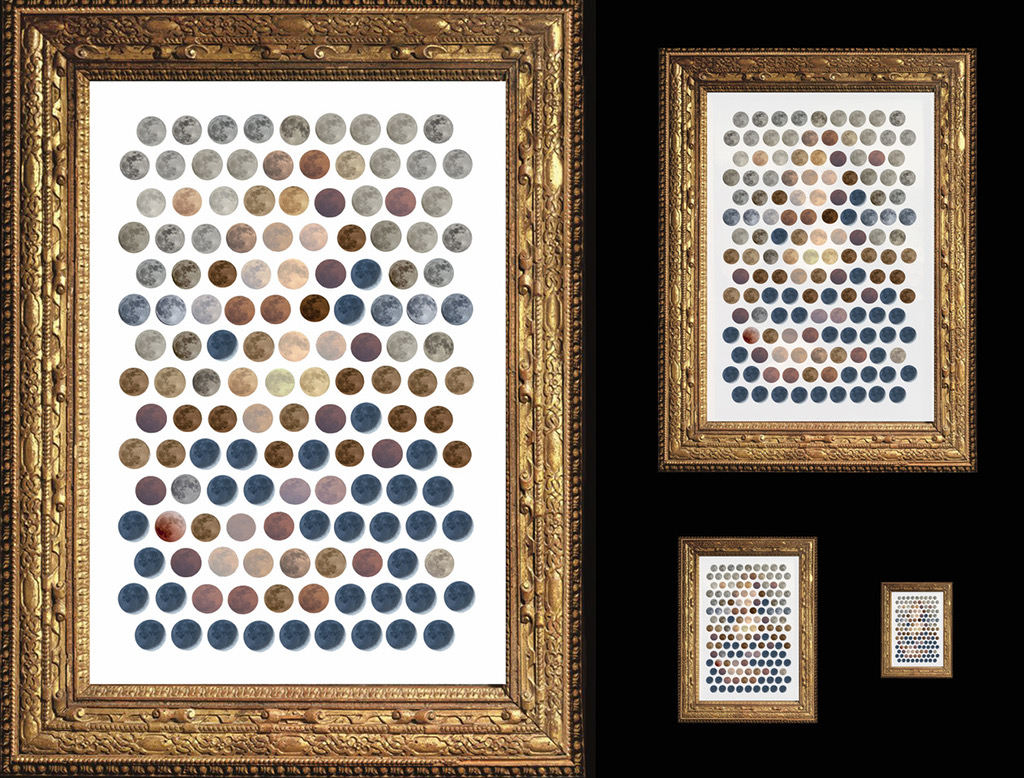14. September 2024
月-nā Lí-sà

探索宇宙1!逐工會揀一幅無仝款 ê 影像抑是相片,𤆬你熟似咱這个迷人 ê 宇宙,閣有專業天文學者2為你3解說4。
- 原始文章:The Moona Lisa
- 影像來源 kah 版權:Gianni Sarcone 佮 Marcella Giulia Pace
- 下暗是:國際賞月暗暝
- 台文翻譯:An-Li Tsai (NSYSU)
[漢羅] 月-nā Lí-sà
這幅有創意 ê 視覺作品,是一粒一粒 tī 地球天頂看著 ê 月娘 自然色。 遮 ê 月盤攏是 tī 無仝時間翕--ê,tī 遮 kā in 一格一格排予好勢。 月球有遮爾濟色調,主要是因為地球大氣 ê 變化,而且 月球、地球、太陽 ê 幾何 排列 嘛會變,造成反射日光 ê 結果嘛會無仝。 Tī 這內底,上暗 ê 月盤是 地球照 造成 ê 月色。 地球照是地球海洋反射日光了後,才閣照 tī 月球較暗彼爿。 這 tī 500 年前,Leonardo da Vinci to̍h 有解說過矣。 毋閣你若是離電腦螢幕較遠咧,抑是你注意看邊仔較細張 ê 版本, 你可能會當看著 da Vinci 彼張上有名 ê 藝術品。
[POJ] Goe̍h-nā Lí-sà
Chit-pak ū chhòng-ì ê sī-kak chok-phín, sī chi̍t-lia̍p-chi̍t-lia̍p tī Tē-kiû thiⁿ-téng khòaⁿ--tio̍h ê Goe̍h-niû chū-jiân-se̍k. Chiah ê goe̍h-pôaⁿ lóng-sī tī bô-kâng sî-kan hip--ê, tī chia kā in tī chi̍t-keh-chi̍t-keh pâi hō͘ hó-sè. Goe̍h-kiû ū chiah-nī chē sek-tiāu, chú-iàu sī in-ūi Tē-kiû tāi-khì ê piàn-hòa, jī-cha̍p Goe̍h-kiû, Tē-kiû, Thài-iông ê kí-hô pâi-lia̍t mā-ē piàn, chō-sêng hoán-siā ji̍t-kng ê kiat-kó mā-ē bô-kâng. Tī chit lāi-té, siōng-àm ê goe̍h-pôaⁿ sī tē-kiu-chiàu hêng-sêng ê goe̍h-se̍k. Tē-kiû-chiàu sī Tē-kiû hái-iûⁿ hoán-siā ji̍t-kng liáu-āu, chiah-koh chiò tī Goe̍h-kiû khah-àm hit-pêng. Che tī 500 nî-chêng, Leonardo da Vinci to̍h ū kái-soeh kòe ah. M̄-koh lí nā-sī lî tiān-náu-êng-bō͘ khah-hn̄g leh, iah-sī lí chù-ì khòaⁿ piⁿ-á khah sè-tiuⁿ ê pán-pún, lí khó-lêng ē-tàng khòaⁿ-tio̍h da Vinci hit-tiuⁿ siōng ū-miâ ê gē-su̍t-phín.
[KIP] Gue̍h-nā Lí-sà
Tsit-pak ū tshòng-ì ê sī-kak tsok-phín, sī tsi̍t-lia̍p-tsi̍t-lia̍p tī Tē-kiû thinn-tíng khuànn--tio̍h ê Gue̍h-niû tsū-jiân-si̍k. Tsiah ê gue̍h-puânn lóng-sī tī bô-kâng sî-kan hip--ê, tī tsia kā in tī tsi̍t-keh-tsi̍t-keh pâi hōo hó-sè. Gue̍h-kiû ū tsiah-nī tsē sik-tiāu, tsú-iàu sī in-uī Tē-kiû tāi-khì ê piàn-huà, jī-tsa̍p Gue̍h-kiû, Tē-kiû, Thài-iông ê kí-hô pâi-lia̍t mā-ē piàn, tsō-sîng huán-siā ji̍t-kng ê kiat-kó mā-ē bô-kâng. Tī tsit lāi-té, siōng-àm ê gue̍h-puânn sī tē-kiu-tsiàu hîng-sîng ê gue̍h-si̍k. Tē-kiû-tsiàu sī Tē-kiû hái-iûnn huán-siā ji̍t-kng liáu-āu, tsiah-koh tsiò tī Gue̍h-kiû khah-àm hit-pîng. Tse tī 500 nî-tsîng, Leonardo da Vinci to̍h ū kái-sueh kuè ah. M̄-koh lí nā-sī lî tiān-náu-îng-bōo khah-hn̄g leh, iah-sī lí tsù-ì khuànn pinn-á khah sè-tiunn ê pán-pún, lí khó-lîng ē-tàng khuànn-tio̍h da Vinci hit-tiunn siōng ū-miâ ê gē-su̍t-phín.
[English] The Moona Lisa
Only natural colors of the Moon in planet Earth's sky appear in this creative visual presentation. Arranged as pixels in a framed image, the lunar disks were photographed at different times. Their varying hues are ultimately due to reflected sunlight affected by changing atmospheric conditions and the alignment geometry of Moon, Earth, and Sun. Here, the darkest lunar disks are the colors of earthshine. A description of earthshine, in terms of sunlight reflected by Earth's oceans illuminating the Moon's dark surface, was written over 500 years ago by Leonardo da Vinci. But stand farther back from your monitor or just shift your gaze to the smaller versions of the image. You might also see one of da Vinci's most famous works of art.
詞彙學習
| 漢羅 | POJ | KIP | 華語 | English |
|---|---|---|---|---|
| 月-nā Lí-sà | Goe̍h-nā Lí-sà | Gue̍h-nā Lí-sà | 月娜麗莎 | The Moona Lisa |
| 幾何 | kí-hô | kí-hô | 幾何 | geometry |
| 月盤 | goe̍h-pôaⁿ | gue̍h-pôann | 月盤 | lunar disk |
| 地球照 | tē-kiû-chiàu | tē-kiû-tsiàu | 地球照 | earthshine |
| 電腦螢幕 | tiān-náu-êng-bō͘ | tiān-náu-îng-bōo | 電腦螢幕 | monitor |